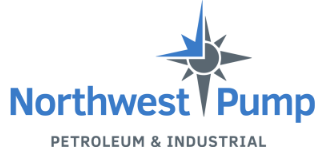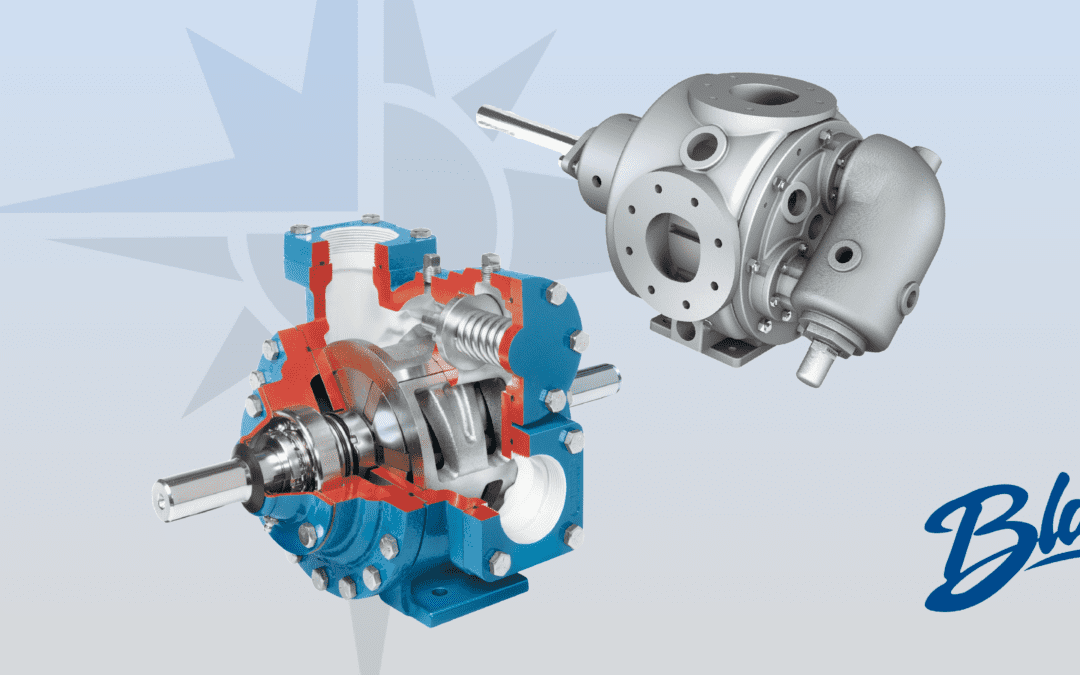In many applications, choosing between sliding vane vs gear pumps is not as much of a clear-cut answer as compared to choosing between two other types of positive displacement pumps. Both overlap in the industries they serve and can often perform the same applications. While both will overlap in performance, here are five reasons a facility may choose a sliding vane pump over a gear pump.
1. Self-Compensating Rotors
The working principle behind gear pumps is that a pair of gears push the liquid from the suction port out and around toward the discharge port. Typically, as gear pumps age, the clearance between the gears and even the pump housing increases, leading to lost efficiency or ‘slippage’. Slippage will continue without any intervention until the pump cannot move fluid through the housing. This common problem led to the first Blackmer sliding vane pump back in 1899, which was engineered to improve upon the gear pump’s lifespan and efficiency.
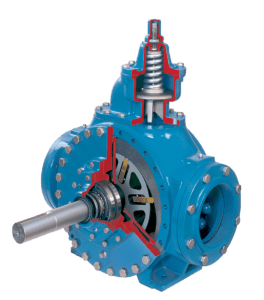
Cutaway of Blackmer HXL8 Pump showing self-compensating rotors
Blackmer uses self-compensating vanes to counteract the wear that gear pumps face. To prevent slippage within sliding vane pumps, Blackmer uses several physical forces to guarantee that the vanes will always maintain positive contact with the pump housing. The first is the rotor’s centrifugal force as it throws the vanes outward towards the pump housing. The second is pressure as the cavities housing the vanes are filled with the liquid. Lastly, in several models, the vanes are attached to the rotor with a spring-loaded pushrod moving opposing pairs of vanes. As the vanes wear over time, these operating principles allow the vanes to self-adjust, preventing slippage and preserving efficiency over the life of the vanes. When noticeable slippage occurs, these vanes can be quickly and easily replaced.
2. Liquid Compatibility
While both vane and gear pumps can work with viscous fluids such as oil or petroleum, sliding vane pumps can also work with:
✅ Thin liquids
✅ Liquid and vapor mixtures
✅ Liquids with suspended solids
Blackmer pumps come in several types of metal to accommodate different chemical compatibility needs. Vanes within the pump come in metallic and non-metallic options to ensure the best compatibility with the application at hand. Blackmer also offers the SX sliding vane series for corrosive and shear-sensitive applications. Check here for a complete liquid compatibility guide for its sliding vane pump materials.
3. Dry-Run Capability
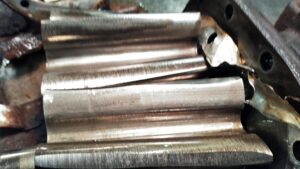
Close-up of a gear pump after running dry
The most significant difference between sliding vane vs gear pumps is the vane pump’s durability, even when not primed. A sliding vane pump can operate dry for several minutes without causing significant damage. Gear pumps have limited self-priming capacity but should never run dry. Without fluid inside the housing, the teeth of the gears will grind and destroy the internal mechanisms of the pump.
4. Coupling Styles & Floor Area Availability
Gear pumps require precise alignment between the shaft moving the gears and the motor. If misaligned, the rotor either pushes the gears into each other where they meet and accelerates wear-and-tear in the pump or pulls them apart, ruining the seal where the gears meet. This fact reduces gear pumps’ coupling styles to close-coupled or mag-driven.
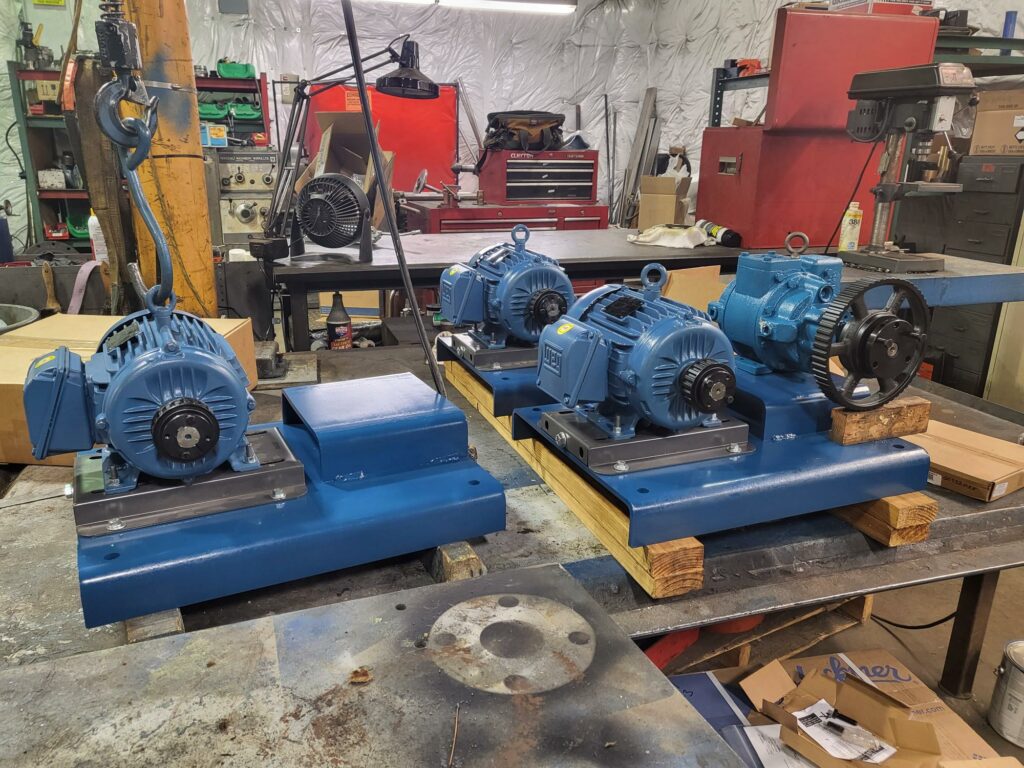
Belt-Driven Blackmer Vane Pump Skids – Assembled at our Portland Pump Shop
Sliding vane pumps have more versatility in coupling style options. Besides close-coupling available with the GNX series, Blackmer vane pumps can be mag-driven, flex-driven, or belt-driven, as seen in the photo above.
5. Maintenance-in-Mind Design
While both pump styles need regular maintenance, Blackmer engineers its sliding vane pump interiors for easy accessibility for maintenance staff, even while the pump is still on-site. Another feature from Blackmer is the cavitation suppression liner. This component surrounds the rotor and vanes of the pump and breaks apart bubbles into smaller sizes, reducing the risks associated with cavitation.
Gear pumps have a complicated assembly process that requires careful handling during disassembly and reassembly. For example, some gear pump manufacturers design their gear pumps to have the mechanical seal behind the shaft of the pump. As a result, maintenance personnel need to disassemble the pump further for seal installations, removals, and repairs compared to other pump manufacturers. Moreover, this restricts their customers to using only proprietary mechanical seals specifically designed to fit in the space.
When to choose a gear pump?
Although sliding vane pumps have certain advantages over gear pumps, there are situations where gear pumps may be a better choice. For example, the benefits of sliding vane pumps may not apply to every application. For instance, if the pump will always have fluid in the wetted housing, having a self-priming pump becomes unnecessary.
Gear pumps will perform better with high-viscosity fluids due to the lower speeds at which they operate. Furthermore, gear pumps typically have fewer moving components, making identifying problems during service inspections easier.
Blackmer offers gear pumps alongside its industry-renowned sliding vane pumps in its robust portfolio. Blackmer Gear pumps offer 95% interchangeability with competitor pumps all while keeping patented design features unique only to Blackmer Gear. Lastly, Blackmer backs its gear pumps with an unmatched 5-year warranty for its gear pumps.
Next Steps
When deciding between sliding vane vs gear pumps the details make a difference. Your Northwest Pump pump experts can help you determine the best pump style for your needs. Reach out to them using the contact button below. For service needs on your pumps, use the request service button.
